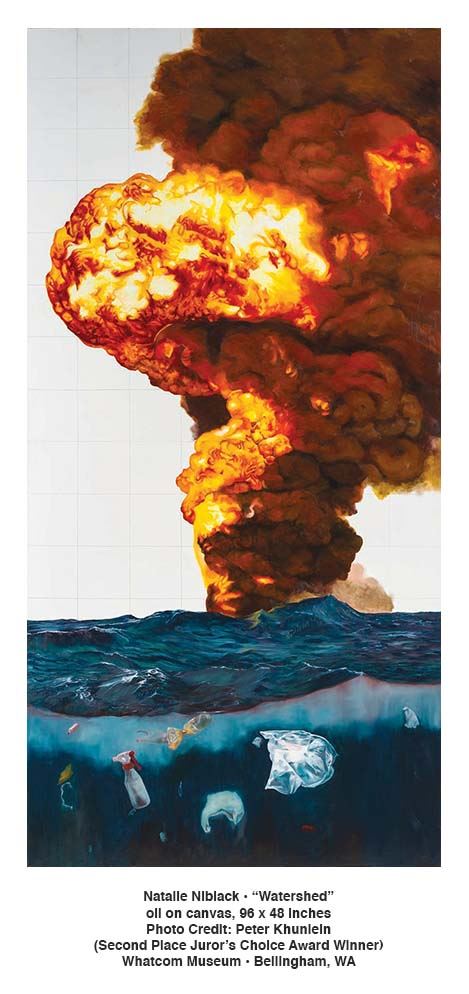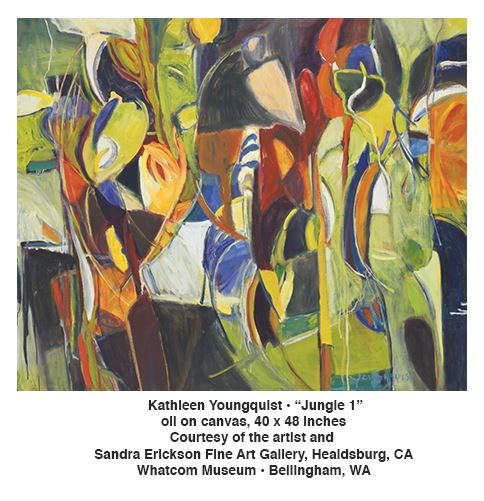 In its third biennial “Bellingham National 2019 Juried Art Exhibition and Awards,” the Whatcom Museum utilized the skills of experienced art historian and curator Bruce Guenther. The theme for this year’s exhibition is “Water’s Edge: Landscapes for Today,” which includes 71 artworks by 57 artists from around the country. As you may expect, Guenther references Bellingham’s location as inspiration for the show’s theme and title, but he also writes in his introductory text that the exhibition “was an invitation for artists to share their observations and feelings about humanity’s ever-changing relationship to nature and life at water’s edge…” Through many different artistic mediums, these artists each grapple with our connection to nature using the landscape as their method of communication.
In its third biennial “Bellingham National 2019 Juried Art Exhibition and Awards,” the Whatcom Museum utilized the skills of experienced art historian and curator Bruce Guenther. The theme for this year’s exhibition is “Water’s Edge: Landscapes for Today,” which includes 71 artworks by 57 artists from around the country. As you may expect, Guenther references Bellingham’s location as inspiration for the show’s theme and title, but he also writes in his introductory text that the exhibition “was an invitation for artists to share their observations and feelings about humanity’s ever-changing relationship to nature and life at water’s edge…” Through many different artistic mediums, these artists each grapple with our connection to nature using the landscape as their method of communication.
The exhibit is not arranged chronologically or by sub theme, so it is fascinating to think about why Guenther placed artworks next to each other. A particularly striking arrangement includes Natalie Niblack’s “Watershed” (oil on canvas), which is flanked by Naomi Shigeta’s “Sky meets Sea” (oil on panel) and Amy Ferron’s “Over our Heads” (acrylic paint and paper on wood). Niblack’s visually imposing painting depicts a large explosion in the top two-thirds of the picture plane, with a trash-filled ocean below. The flames are painted in extraordinary detail and loom over the viewer. She has also drawn a grid in the white background behind the plume of fire and smoke. Is this her attempt to create an underlying structure beneath the swirling flames? Interestingly, Shigeta and Ferron also utilize straight lines to create structure in their paintings. Shigeta writes in her statement that the painting, especially the distinct vertical lines, “reflects the challenge in keeping balance.” Ferron creates her landscapes by first cutting paper with rotary cutters and X-acto knives and then pasting the pieces together. The result is a mosaic landscape reminiscent of the geometric structures of Nature: tectonic plates, molecules, and others. 
Connections between Nature, Art, and Science are abundant in the exhibition. There are many photographs, including two tintypes by Alexandra Opie, included in the show which have long been used by scientists to document the natural world. Lynn Skordol printed on a vintage map to create “Map 4” to illustrate how humans have changed the natural landscape over the years. Vanessa Mayoraz’s “Progressions of pernicious change” almost appears to have been taken straight from a science lab. She writes that her “work concerns itself with understanding and decoding our reality,” which beautifully demonstrates the “power of place” that Guenther writes about in his introductory text.
Guenther awarded three cash prizes to artists in the exhibition. The Second Place winner was Natalie Niblack. First Place went to Philip Govedare’s vibrant, oil on canvas painting titled “Artifact.” Like other artists in the exhibition, Govedare also contemplates the impact of land use and his paintings are charged with doubt and anxiety about the condition of the landscape. His use of bright red signals alarm. In contrast, the Third Place winner, Patti Bowman connects her encaustic “Wave I” to the effect of gazing at the ocean. The painting purposefully lacks structure to orient the view, which gives the affect of an endless sea or enormous wave filling the picture plane with blue water and white foam.

While all three award winners are based in Washington State, the exhibition drew many artists from all around the country. And even though all the artworks are 2-dimensional, the exhibition does not lack in variety of mediums or artistic styles. If you are interested in representational paintings of the landscape, you will find several. If you are looking for abstract paintings seeking to find the essence of nature, Guenther has included many with this exact aim, but they utilize different methods for seeking the “spirit of nature.” The exhibition consists of many paintings, but photographs and prints are also in abundance. There are even several fiber artworks, including Krista Kilvert’s “Altered Landscape” (dye sublimation on polyester) which moved with the air flow as I opened the door to the gallery. 
As I was leaving the gallery, I looked up at the second story to see a canoe through a cut out in the wall. The canoe is part of the “People of the Sea and Cedar” exhibition and seeing the object beautifully connected both exhibitions through the “power of the essential element Water to life,” as Guenther writes in his text. I suggest visiting both exhibitions while you are at the Whatcom Museum.
Chloé Dye Sherpe
Chloé Dye Sherpe is a curator and art educator
based in Washington State.
 “Bellingham National 2019” is on view Wednesday through Sunday from 12 to 5 P.M. through May 19 at the Whatcom Museum’s Lightcatcher Building, located at 250 Flora Street in Bellingham, Washington. For more information, visit www.whatcommuseum.org.
“Bellingham National 2019” is on view Wednesday through Sunday from 12 to 5 P.M. through May 19 at the Whatcom Museum’s Lightcatcher Building, located at 250 Flora Street in Bellingham, Washington. For more information, visit www.whatcommuseum.org.